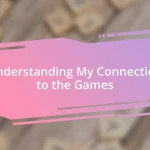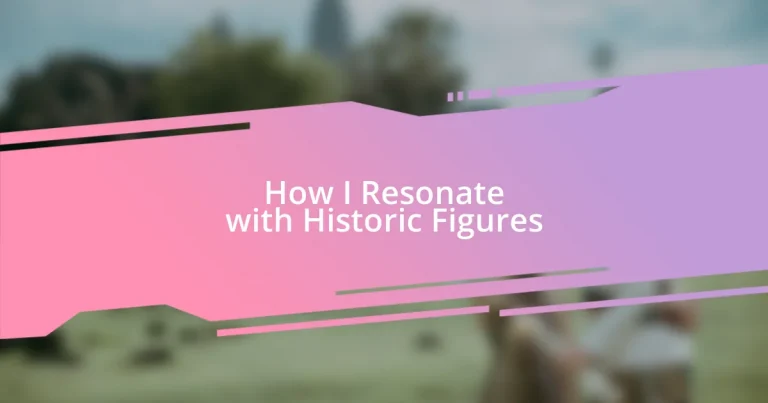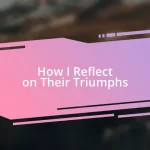Key takeaways:
- Resonating with historic figures creates emotional connections, inspiring personal growth and reflection on shared struggles.
- Exploring shared values and beliefs with historical figures encourages individuals to embrace their own principles and take action in their lives.
- Applying lessons from the lives of historic figures provides a framework for navigating modern challenges and crafting a personal narrative rooted in authenticity and resilience.
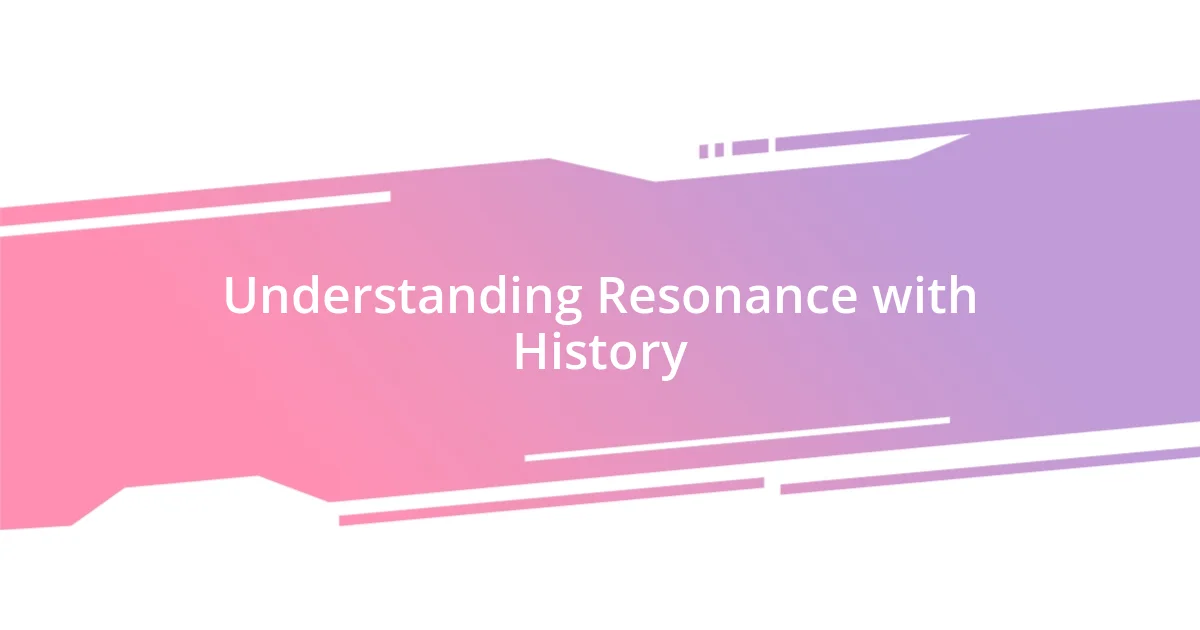
Understanding Resonance with History
Resonating with history is about more than just facts and dates; it’s an emotional connection to the people who shaped our world. I remember the first time I read about Amelia Earhart. Her daring spirit made me question my own limitations and ignited a desire to push beyond them. Can’t you feel a surge of inspiration when you learn about someone who defied the odds?
When we explore historic figures, we often find pieces of ourselves reflected in their stories. I once found comfort in the resilience of Nelson Mandela during my own challenging times. It was a reminder that struggle can lead to profound change. Don’t you think these connections make history feel more relevant and alive?
Understanding resonance involves recognizing our shared human experiences. I vividly recall visiting a museum dedicated to the Civil Rights Movement. It felt surreal to stand where people fought for their rights, and I couldn’t help but feel a deep sense of gratitude and responsibility. What if we all took a moment to reflect on how these stories influence our lives today?
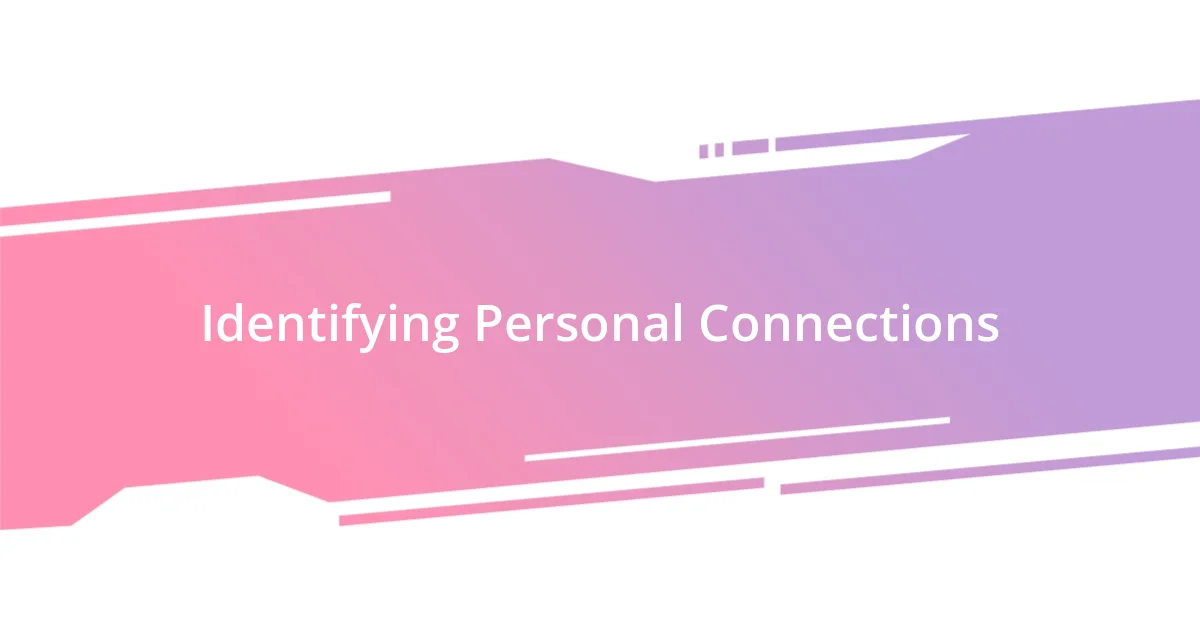
Identifying Personal Connections
Identifying personal connections with historic figures often starts with introspection. I’ve found that when I think about my own journey, I can see parallels with figures like Malala Yousafzai, whose advocacy for education resonates with my passion for learning. Her bravery at such a young age pushes me to reflect on my own contributions, no matter how small. Have you ever thought about how your life experiences mirror those of someone from the past?
In another instance, I felt a deep connection to Frida Kahlo during a creative phase in my life. Her ability to transform pain into art spoke to my own struggles with expressing emotions. I realized that her fight for identity and self-expression paralleled my own search for personal authenticity. How often do we overlook these shared struggles when reading about the lives of others?
Finally, I think about how identifying with historic figures allows us to embrace vulnerability. While reading about the challenges faced by Albert Einstein early in his career, I felt a sense of relief knowing that even brilliant minds faced setbacks. His journey encouraged me to view my failures as stepping stones to success. Can you identify moments in history that resonate with your personal challenges, too?
| Historic Figure | Personal Connection |
|---|---|
| Amelia Earhart | I felt inspired to challenge my own limits. |
| Nelson Mandela | His resilience mirrored my own struggles. |
| Frida Kahlo | Her art helped me express my emotions. |
| Albert Einstein | His setbacks reminded me that failure is part of the journey. |
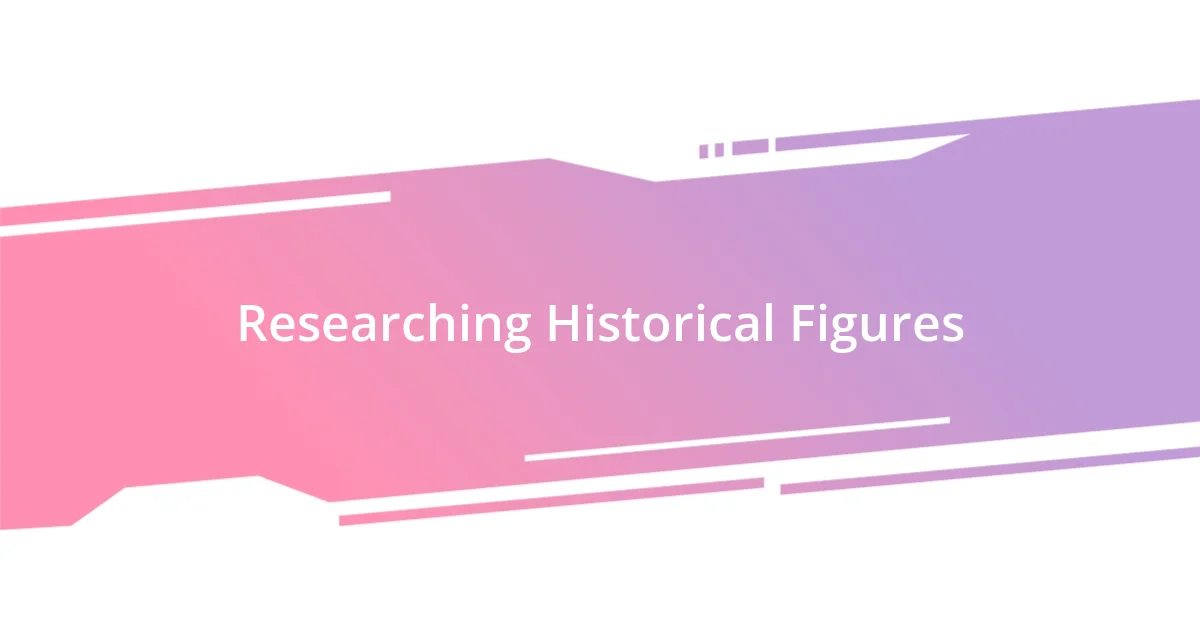
Researching Historical Figures
Researching historical figures can be a fascinating journey, akin to piecing together a puzzle. I recall my excitement when delving into the life of Maya Angelou. I had only heard snippets of her poetry, but learning about her experiences of trauma and triumph profoundly impacted me. Reflecting on her resilience not only deepened my admiration but also encouraged me to confront my own challenges. It’s in these connections that we truly uncover the lessons from history.
- Start with Primary Sources: Read autobiographies or letters to grasp personal experiences.
- Explore Documentaries: Visual storytelling often brings a human touch to historical facts.
- Engage with Scholarly Analysis: Academic papers can provide depth and context to their lives.
- Visit Historical Sites: Immersing yourself in places where they lived or worked can spark profound realizations.
- Join Discussions or Forums: Engaging with others can uncover new perspectives and insights.
Researching these figures invites us to step into their shoes—feeling their struggles, their victories, and ultimately, recognizing bits of ourselves within their narratives. It’s a rewarding process that enriches our understanding of history and humanity.
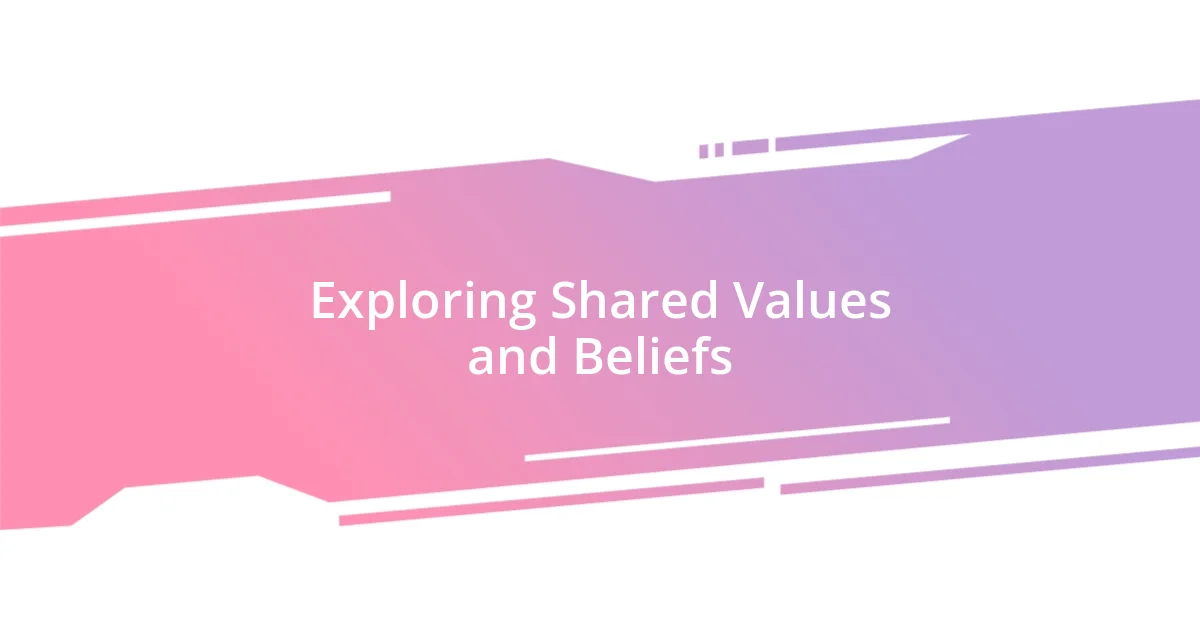
Exploring Shared Values and Beliefs
Understanding the shared values and beliefs with historic figures often feels like a mirror reflecting my own principles back at me. Recently, I was struck by how similar my commitment to social justice aligns with the beliefs of figures like Rosa Parks. Her brave refusal to give up her bus seat ignited a movement that still inspires me today. Have you ever pondered how your actions align with those of someone who sparked change?
It’s fascinating to consider how values like courage and perseverance shape not only the past but also the present. I remember reading about Gandhi’s philosophy of nonviolent resistance. It resonated deeply during a challenging moment in my life when I had to stand my ground without resorting to anger. This led me to ask myself: how can I embody such ideals in my everyday actions? Each time I reflect on these beliefs, I find greater strength in my own choices.
On a more personal note, I see parallels with Mother Teresa’s compassion in my desire to make a difference, no matter how small. There was a time I volunteered at a local shelter, and meeting people who were struggling truly humbled me. It made me realize that sharing kindness—even in the face of adversity—can foster hope. Isn’t it beautiful how our values can guide our paths, connecting us with historic figures in meaningful ways?
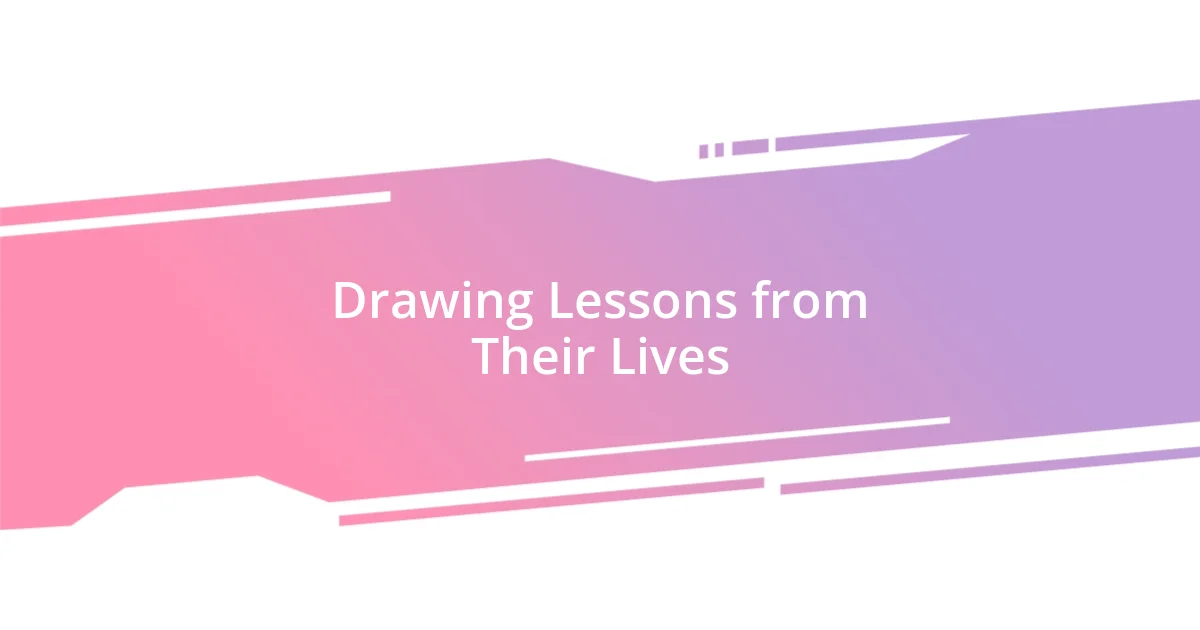
Drawing Lessons from Their Lives
Drawing lessons from the lives of historic figures often leads to remarkable insights that can influence our choices today. For instance, when I explored the life of Nelson Mandela, I was deeply moved by his unwavering commitment to freedom and justice despite enduring 27 years in prison. In my own life, whenever I face obstacles, I recall his famous words, “It always seems impossible until it’s done.” This quote inspires me to push through my own challenges—reminding me that perseverance can change the course of history.
I also find that reflecting on the failures of great leaders teaches just as much as their successes. Take Thomas Edison, for example. His countless failed attempts before inventing the light bulb resonate with me on a personal level. I remember my own struggles when trying to learn a new skill; it felt daunting at times. But Edison’s belief that, “I have not failed. I’ve just found 10,000 ways that won’t work,” encourages me to embrace my missteps. Isn’t it fascinating how such historical experiences translate into motivation for today’s aspirations?
Engaging with the emotional journeys of figures like Anne Frank highlights the triumph of hope in adversity. Reading her words in “The Diary of a Young Girl” stirs something profound within me. I can’t help but feel a connection to her youthful dreams and the pain of confinement. It compels me to question: how can I nurture hope in my own life during tough times? This connection reminds me that, despite our circumstances, cultivating resilience is a lesson that spans generations.
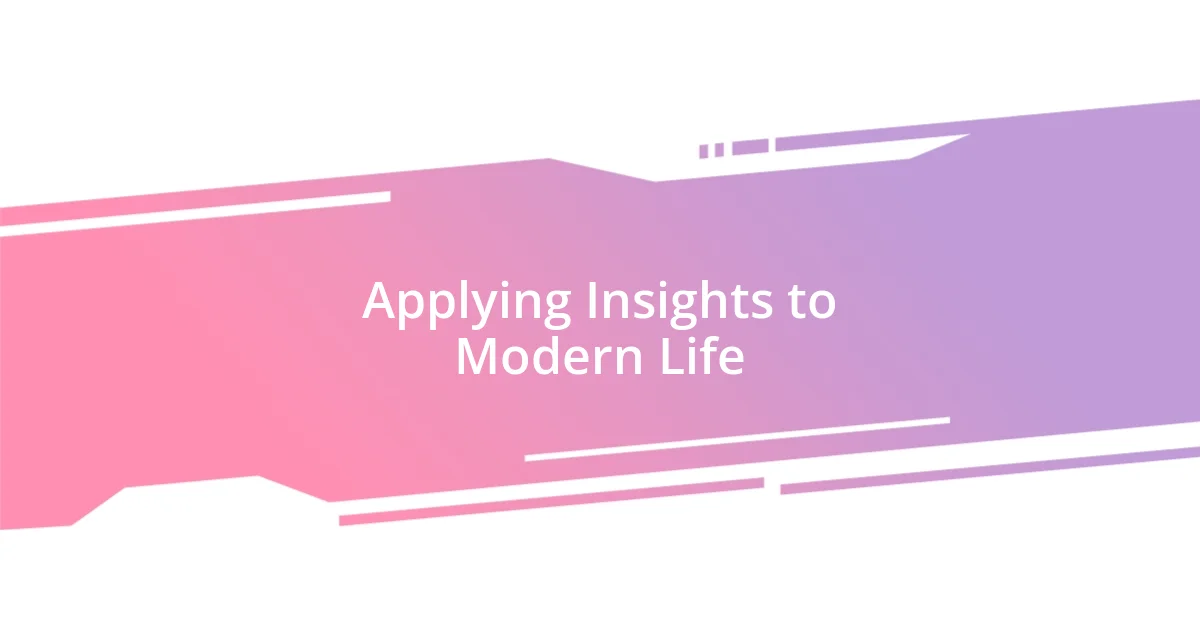
Applying Insights to Modern Life
Applying insights from historic figures doesn’t just enrich my understanding; it provides a powerful framework for navigating modern challenges. I remember a time when I was inundated with work and felt overwhelmed. I thought about how Howard Zinn, a passionate historian, advocated for the voices of the marginalized. This reflection urged me to prioritize compassion, not only towards others but also towards myself. It’s intriguing to consider how we can occasionally treat ourselves with the same understanding that we extend to others, isn’t it?
In my daily life, I find inspiration in Eleanor Roosevelt’s belief that “no one can make you feel inferior without your consent.” When I face moments of self-doubt, her words echo in my mind, reminding me that my self-worth is something I can nurture. I strive to embody her spirit by celebrating my achievements, however small. Have you ever thought about how affirming your own worth can ripple out, empowering those around you?
The ethical dilemmas faced by figures like Martin Luther King Jr. resonate deeply with my own decisions today. His commitment to justice often prompts me to stand firm against injustices, even in casual conversations. I once found myself in a discussion where I could’ve chosen silence, but remembering King’s courage kindled the resolve to speak up. It made me realize: every choice we make, whether big or small, shapes the kind of world we collectively echo from the past.
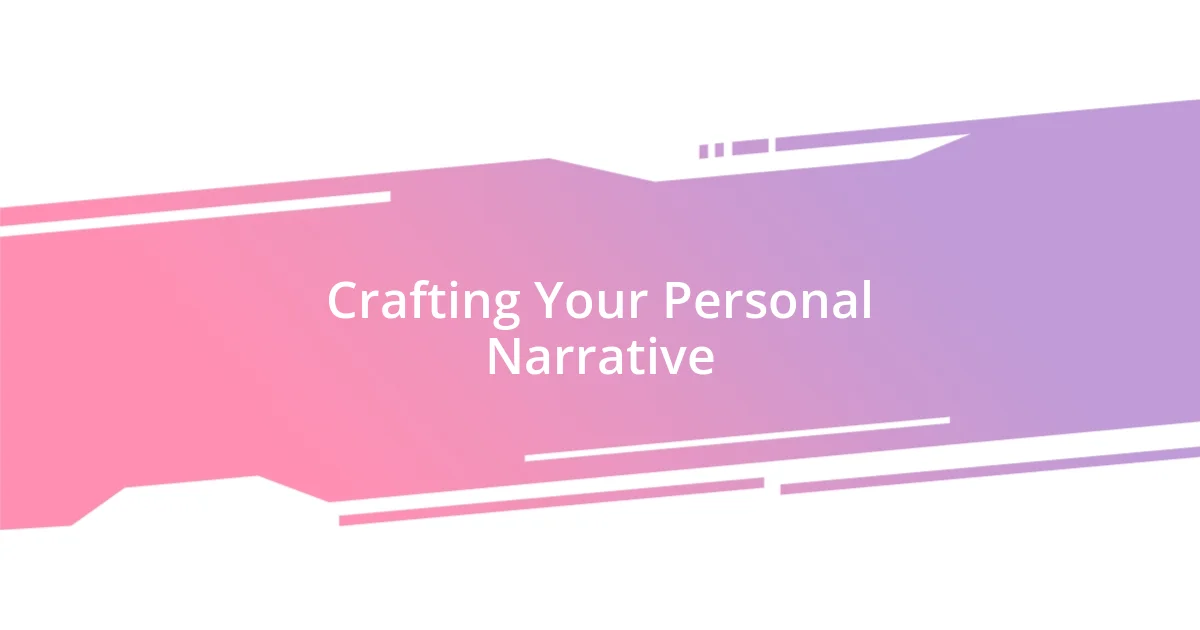
Crafting Your Personal Narrative
Crafting your personal narrative is about weaving your experiences and reflections into a story that resonates with who you are today. I often think back to my childhood when I discovered my love for storytelling. I would spend hours with my grandmother, listening to her recount tales from her youth filled with courage and struggle. Those stories shaped my own narrative, reminding me that every experience, even the mundane, adds depth and character to who I ultimately become.
As I reflect on my journey, I realize the importance of authenticity in crafting my narrative. I still vividly recall a time when I chose to showcase my vulnerability while giving a speech at a community event. Sharing my struggles with anxiety not only made me feel lighter but also connected me with others who shared similar battles. It’s incredible how being open can foster connection. Have you ever thought about how vulnerability can serve as a bridge rather than a barrier? This approach has helped me redefine my story—not as one of isolation, but rather one of shared strength.
To truly connect with historic figures, I find it essential to acknowledge not just their triumphs but their struggles, much like my own. Reflecting on the challenges faced by someone like Frida Kahlo has opened my eyes to the beauty of resilience. Her art, born from pain, inspires me to embrace my own creative expressions as a means of healing. Each brushstroke, whether it’s a joyous moment or a melancholic one, tells a part of her story that echoes in my heart. How do the struggles you face weave into the tapestry of your own life narrative? Finding these links can lead to profound insights that shape both your past and your future.











